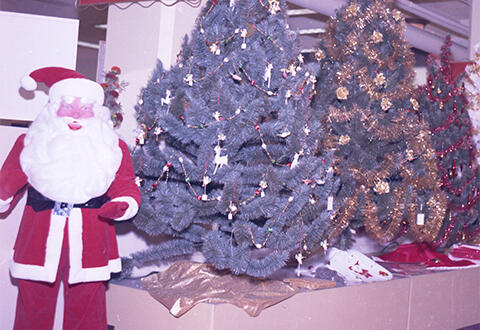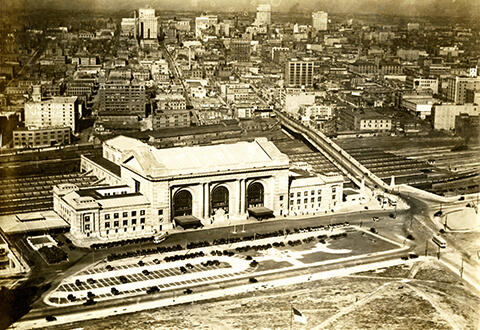’Tis the season for nostalgia: a time to reminisce about Christmases past and beloved holiday traditions. Many Kansas Citians have fond memories of the brightly lit Christmas Crowns that once illuminated the downtown shopping district and warmly recall festive department store displays. Shiny new toys under beautifully decorated Christmas trees, model trains chugging through snowy townscapes, and mechanical elves, reindeer, and carolers were hallmarks of the holiday shopping experience.
Local History Blog
The holiday spirit is in full swing in Kansas City and, to help celebrate, we’re responding to a reader who asked about the origins of the lights on the Country Club Plaza – one of the most notable Christmas light traditions in the country.
The Scout statue in Penn Valley Park has kept watch over downtown Kansas City for almost a century. Since its dedication in 1922, it has become a symbol and mascot for the city and a favorite subject for generations of photographers. But look through some of those photos over the years, and you may – or may not – see a few things intermittently missing. Reader Jeffrey Swoyer is a life-long Kansas Citian. He admits that he never paid much attention to The Scout until a visit with an out-of-town friend who had noticed the photographic disparities. Some pictures show the quiver on the rider’s back, some don’t.
There are 147 names recorded in what is interchangeably called the “Honor Book,” “Honor Roll,” and the “War Record of Pages of Kansas City Public Library.” It was created by John Rankin Greenlee, Chief of the Stacks of the old Main Library building at 9th and Locust, who took it upon himself to record and track former library pages and assistants who served in World War II. (Higher level employees don’t appear to have been included.) Now, just in time for Veterans Day of 2020, the book has been digitized and made available on kchistory.org. Inside the sticker-clad cover, the book contains photos, articles, newsletter pages, and additional information about former library staffers. Some pages only include a name and a brief note of where they were stationed in the service or which library department or branch they worked in. Other pages have photos and newspaper clippings pasted onto them, sometimes obscuring other information.
The ghost of St. Mary’s Episcopal Church is back to haunt “What’s your KCQ?” for an encore appearance during this spooky Halloween season. Proceed at your own risk. Jason Dean, a parishioner at St. Mary’s Episcopal Church, wrote of hearing about a controversial priest who died in 1886 and haunts the church to this day. In conjunction What’s Your KC BOO?, our special Halloween edition of What’s Your KC Q focusing on Kansas City’s haunted lore, he asked us to investigate. We found … intrigue. St. Mary’s wasn’t St. Mary’s when the church was first established in 1854. St. Luke’s Mission, as it was initially known, had humble beginnings. Lacking a permanent home, its congregation met at a variety of locations near today’s River Market neighborhood. The church prospered and, by 1867, had purchased a lot on the southeast corner of Eighth and Walnut and erected its first permanent home.
Urban development in Kansas City took off at the end of World War II when the American Housing Act, part of President Truman’s Fair Deal, allowed for cities to demolish blighted areas to make way for new public housing.
Imagine for a moment that you’re enjoying a pleasant day at the Kansas City Zoo. You’ve seen lions, tigers and even a swimming polar bear. You notice a path leading away from the main trail and what looks like a bridge straight out of Jurassic Park.
It’s a story that has become a part of Kansas City baseball lore: a local team enlisting famed frontier lawman Wild Bill Hickok to umpire a game against a heated rival. How much, if any of it, is true?










